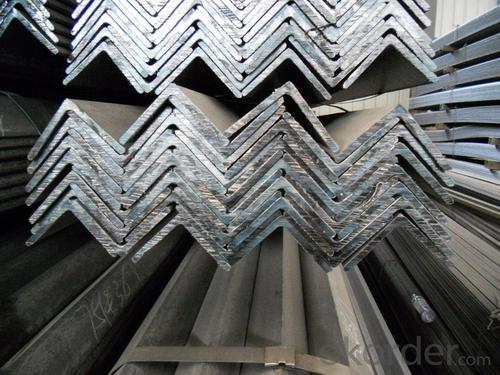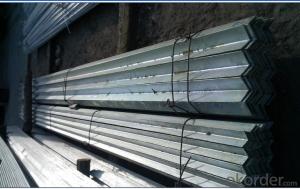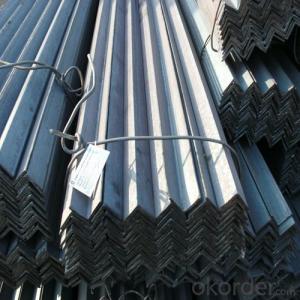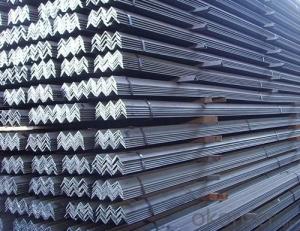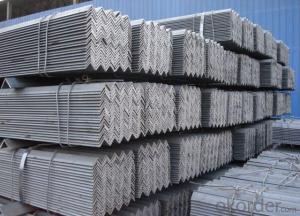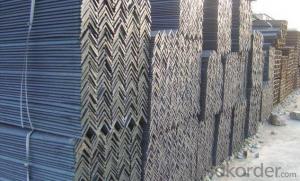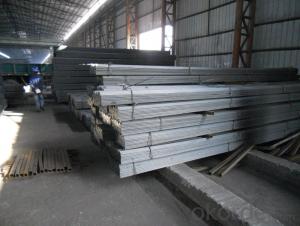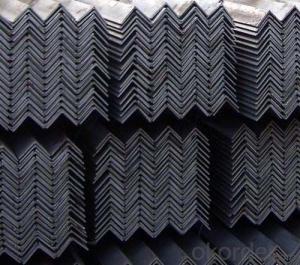Steel Equal Angle with Good Quality 130mm-140mm
- Loading Port:
- Tianjin
- Payment Terms:
- TT OR LC
- Min Order Qty:
- 50 m.t
- Supply Capability:
- 15000 m.t/month
OKorder Service Pledge
OKorder Financial Service
You Might Also Like
Specification
Product Description:
Specifications of Steel Equal Angle with Good Quality 130mm-140mm:
1. Invoicing on theoretical weight or actual weight as customer request
2. Length: 6m, 9m, 12m as following table
3. Sizes
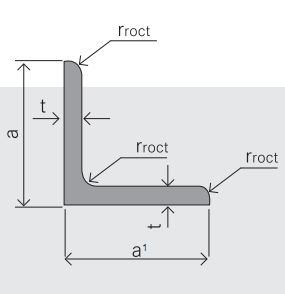
| Size(mm) | Mass(Kg/m) | Size(mm) | Mass(Kg/m) |
| 130*130*10.0 | 19.625 | 140*140*12.0 | 25.522 |
| 140*140*10.0 | 21.488 | 140*140*14.0 | 29.49 |
Payment terms:
1).100% irrevocable L/C at sight.
2).30% T/T prepaid and the balance against the copy of B/L.
3).30% T/T prepaid and the balance against L/C
Material details:
Grade | Element (%) | ||||
C | Mn | S | P | Si | |
Q235 | 0.12—0.20 | 0.3—0.7 | ≤0.045 | ≤0.045 | ≤0.3 |
Usage & Applications of Steel Equal Angle with Good Quality 130mm-140mm:
According to the needs of different structures, Angle can compose to different force support component, and also can be the connections between components. It is widely used in various building structures and engineering structures such as roof beams, bridges, transmission towers, hoisting machinery and transport machinery, ships, industrial furnaces, reaction tower, container frame and warehouse etc.
Packaging & Delivery of Steel Equal Angle with Good Quality 130mm-140mm:
1. Packing: it is nude packed in bundles by steel wire rod
2. Bundle weight: not more than 3.5MT for bulk vessel; less than 3 MT for container load
3. Marks:
Color marking: There will be color marking on both end of the bundle for the cargo delivered by bulk vessel. That makes it easily to distinguish at the destination port.
Tag mark: there will be tag mark tied up on the bundles. The information usually including supplier logo and name, product name, made in China, shipping marks and other information request by the customer.
If loading by container the marking is not needed, but we will prepare it as customer request.
Production flow of Steel Equal Angle with Good Quality 130mm-140mm:
Material prepare (billet) —heat up—rough rolling—precision rolling—cooling—packing—storage and transportation
FAQ:
Q1: Why buy Materials & Equipment from OKorder.com?
A1: All products offered byOKorder.com are carefully selected from China's most reliable manufacturing enterprises. Through its ISO certifications, OKorder.com adheres to the highest standards and a commitment to supply chain safety and customer satisfaction.
Q2: How do we guarantee the quality of our products?
A2: We have established an advanced quality management system which conducts strict quality tests at every step, from raw materials to the final product. At the same time, we provide extensive follow-up service assurances as required.
Q3: How soon can we receive the product after purchase?
A3: Within three days of placing an order, we will begin production. The specific shipping date is dependent upon international and government factors, but is typically 1 to 2 months.
Q4: How many tons can be loaded into one 20ft container?
A4: Around 23—25tons
Images of Steel Equal Angle with Good Quality 130mm-140mm:


- Q: Can steel angles be used for acoustic isolation or noise barriers?
- Steel angles can be used for acoustic isolation or noise barriers, although they may not be as effective as other materials specifically designed for this purpose. Steel angles can help to reduce noise transmission to some extent by reflecting and absorbing sound waves. However, their effectiveness depends on various factors such as the thickness and density of the steel, as well as the overall design and construction of the barrier. Additionally, steel angles are not typically designed to have soundproofing properties, so using them alone may not provide optimal acoustic isolation. It is recommended to consider specialized materials and techniques specifically designed for noise barriers to achieve the best results.
- Q: How are steel angles used in structural framing?
- Steel angles are commonly used in structural framing as they provide stability and support. They are often used to reinforce corners and joints, adding strength to the overall structure. Steel angles are also used as braces and supports in various construction projects, helping to distribute weight and prevent sagging or collapsing.
- Q: Can steel angles be used in earthquake-resistant construction?
- Yes, steel angles can be used in earthquake-resistant construction. Steel angles are commonly used as structural members in buildings because of their high strength and durability. In earthquake-resistant construction, steel angles can be utilized to provide additional bracing and reinforcement to the building's structural system. By designing and incorporating steel angles in strategic locations, such as at the corners of the building or along the edges of walls, they can help distribute earthquake forces more effectively and reduce the risk of structural failure. Additionally, steel angles can be used to create moment-resisting frames or as part of a steel moment frame system, which is highly effective in resisting lateral forces during an earthquake. Overall, steel angles can play a crucial role in enhancing the seismic performance of a building and can be a valuable component in earthquake-resistant construction.
- Q: Are steel angles available in different alloys?
- Yes, steel angles are available in different alloys.
- Q: What are the different methods for cutting steel angles?
- There are several different methods for cutting steel angles, depending on the specific requirements and the tools available. Some of the most common methods include: 1. Manual cutting: This involves using a handheld hacksaw or a metal cutting bandsaw to cut through the steel angle. It is a labor-intensive method and may not be suitable for large-scale projects or precise cuts. 2. Abrasive cutting: This method uses an abrasive wheel or disc to grind through the steel angle. It is commonly done with an angle grinder or a chop saw. Abrasive cutting is faster than manual cutting and can provide reasonably accurate cuts. 3. Plasma cutting: Plasma cutting involves using a high-temperature plasma arc to melt through the steel angle. It is a versatile method that can cut through thick steel angles quickly and accurately. However, it requires specialized equipment and may not be suitable for small-scale or on-site projects. 4. Laser cutting: Laser cutting uses a high-powered laser beam to melt through the steel angle. It is a precise and efficient method that can produce intricate cuts with minimal heat-affected zones. Laser cutting is commonly used in industrial settings and requires specialized equipment. 5. Waterjet cutting: Waterjet cutting utilizes a high-pressure jet of water mixed with abrasive particles to cut through the steel angle. It is a versatile method that can produce precise cuts without generating heat or causing distortion. Waterjet cutting is commonly used in industries where heat-affected zones and material distortion are a concern. 6. Shearing: Shearing involves using a shear machine to apply a cutting force to the steel angle, causing it to fracture along a predetermined line. It is a fast and efficient method for straight cuts and is commonly used for high-volume production. The choice of cutting method depends on various factors such as the size and thickness of the steel angle, the desired accuracy of the cut, the available equipment, and the project requirements. It is important to consider the specific needs and limitations before selecting the most appropriate cutting method.
- Q: What are the different design considerations for steel angles in architectural applications?
- When it comes to using steel angles in architectural applications, there are several design considerations that need to be taken into account. These considerations include the load-bearing capacity of the angles, their structural integrity, aesthetics, and overall design flexibility. One of the primary design considerations for steel angles in architectural applications is their load-bearing capacity. Steel angles are often used to provide structural support in buildings, so it is crucial to ensure that they can withstand the anticipated loads. This involves calculating the maximum load that the angles will need to bear and selecting angles with the appropriate size and thickness to handle these loads safely. Another important consideration is the structural integrity of the steel angles. Architects and engineers need to consider factors such as the angle's resistance to bending, buckling, and shear. The design should take into account the angle's ability to distribute the loads evenly, minimizing the risk of failure or deformation. Aesthetics also play a significant role in architectural design, and steel angles can contribute to the overall visual appeal of a building. Architects may choose to incorporate angles with different profiles, finishes, or decorative elements to enhance the design and create a visually appealing structure. The angles should complement the overall architectural style and blend seamlessly with other building materials. Design flexibility is another crucial consideration when using steel angles. Architects often require angles that can be easily customized or fabricated to meet their specific design requirements. Steel angles can be cut, welded, or bent to create unique shapes and angles, allowing for creative architectural solutions. Lastly, it's important to consider the material properties and corrosion resistance of the steel angles. Architects need to evaluate the environmental conditions of the project site and select angles that can withstand exposure to moisture, chemicals, or other corrosive agents. Proper coatings or treatments can be applied to protect the angles from corrosion and ensure their longevity. In conclusion, the design considerations for steel angles in architectural applications encompass load-bearing capacity, structural integrity, aesthetics, design flexibility, and corrosion resistance. By carefully considering these factors, architects can select steel angles that meet both the functional and visual requirements of their projects, resulting in safe, durable, and visually appealing architectural structures.
- Q: What are the different packaging options for steel angles?
- The customer's specific needs and transportation method determine the various packaging options available for steel angles. Common options include: 1. Bundles: Steel angles can be bundled together using steel straps or wires. This option is suitable for larger quantities and provides stability and ease of handling. 2. Pallets: Steel angles can be placed on wooden or plastic platforms for easy transportation and storage. They are secured to the pallet using straps or stretch wrap. 3. Crates: Wooden crates offer extra protection for steel angles, making them ideal for long-distance transportation or outdoor storage. 4. Steel Cages: Steel angles can be packaged in metal cages with open sides for visibility and ventilation. This option is useful for bulk quantities. 5. Customized Packaging: Steel angles can be packaged according to specific customer requirements, such as adding protective materials like foam or plastic sheets to prevent damage during transit. It's important to consider factors like size, weight, transportation mode, and regulations when choosing a packaging option for steel angles.
- Q: Is there a screw that can be made like angle iron, but not a right angle, just a single piece of material? That's the way to break the angle iron in two. What if it's called? Thank you, professionals!
- As for the cutting of wood cutting machine can cut metal with no blade, you can find a corner grinder to cut angle grinder specifications you can use with 100 or 125 with the same diameter, diameter, cutting slice thickness 3mm, slice should be perpendicular to the cutting piece.
- Q: How do steel angles perform under wind loads?
- Steel angles are commonly used in construction for their strength and stability. When subjected to wind loads, steel angles perform exceptionally well due to their rigidity and ability to distribute the forces evenly. The shape of the angle, with its two legs forming a right angle, helps to resist bending and twisting caused by wind pressure. Overall, steel angles provide reliable support and structural integrity even in high wind conditions.
- Q: Can steel angles be used in the construction of theatres?
- The utilization of steel angles in theatre construction is indeed possible. Their strength and versatility make them common structural components in construction. They offer stability and support, making them suitable for various theatre construction applications. Steel angles can be employed in theatres to establish the framework for stage platforms, catwalks, and balconies. They can also be used to support lighting fixtures, rigging systems, and sound equipment. Additionally, they can reinforce the structural integrity of the theatre building itself, such as beams, columns, and trusses. The advantages of using steel angles in theatre construction are plentiful. Firstly, steel is a durable and long-lasting material, ensuring the stability and safety of the theatre structure over time. Moreover, steel angles can be easily customized and fabricated to meet specific design requirements, allowing for flexibility in theatre construction. Furthermore, steel angles possess fire-resistant properties, which are of utmost importance in theatre environments where fire safety is a priority. They can withstand high temperatures and provide structural support even in the event of a fire, guaranteeing the safety of both the building and its occupants. Overall, steel angles are an excellent choice for theatre construction due to their strength, versatility, and fire-resistant properties. They furnish the necessary structural support and stability required for the unique needs of theatre spaces, ensuring a safe and functional environment for performances and audiences alike.
Send your message to us
Steel Equal Angle with Good Quality 130mm-140mm
- Loading Port:
- Tianjin
- Payment Terms:
- TT OR LC
- Min Order Qty:
- 50 m.t
- Supply Capability:
- 15000 m.t/month
OKorder Service Pledge
OKorder Financial Service
Similar products
Hot products
Hot Searches
Related keywords



